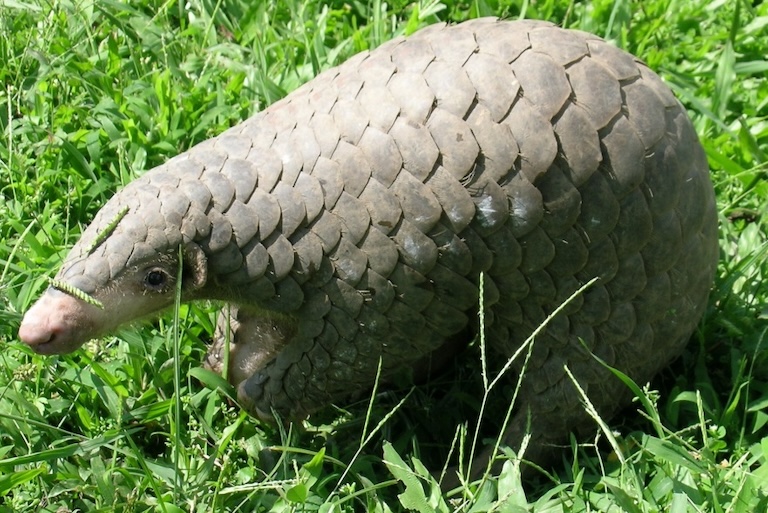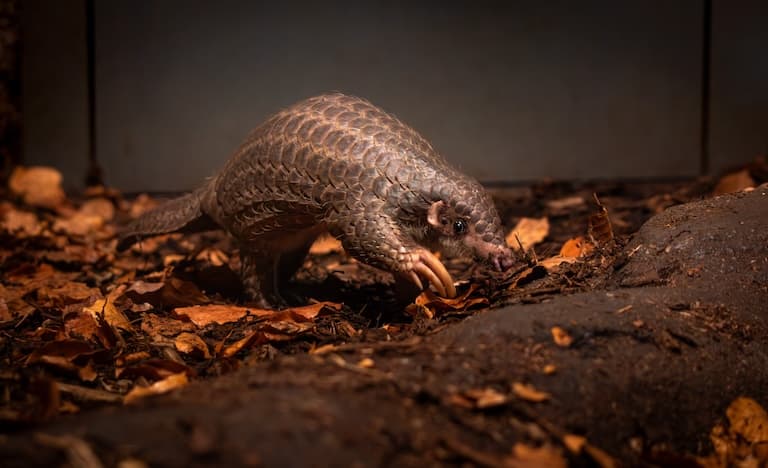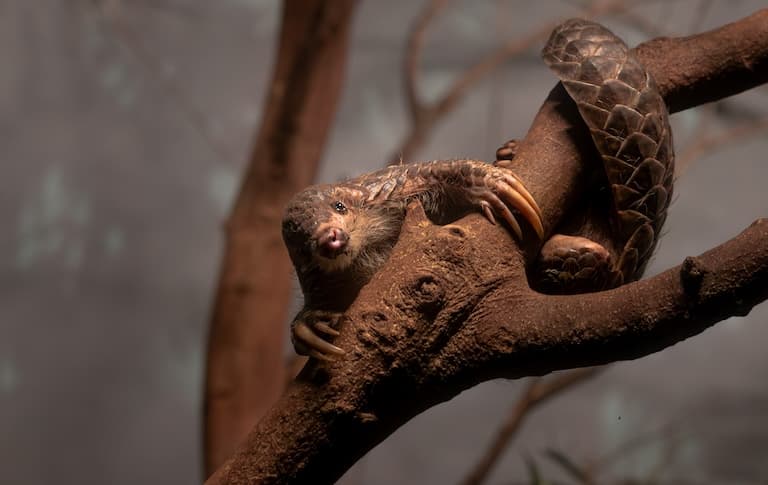Chinese Pangolin Profile
Pangolins are an ancient branch of mammals, most closely related to the Carnivorans, but separated from this group around 80 million years ago.
Since then, they have been widespread and diverse, but today only eight species remain: two genera in Africa with two each, and one Asian genus, Manis, within which the Chinese pangolin sits, threatened, like its relatives, with imminent extinction.

Chinese Pangolin Facts Overview
| Habitat: | Subtropical and deciduous forests |
| Location: | China to the Himalayan region |
| Lifespan: | Unknown |
| Size: | 60 cm (2 ft) long with an 18 cm tail (7 in) |
| Weight: | 5kg (11 lb) to 8kg (18 lb) |
| Colour: | Brown to black scales, lighter belly |
| Diet: | Almost exclusively ants and termites |
| Predators: | Humans |
| Top Speed: | Slow |
| No. of Species: | 1 |
| Conservation Status: | Critically Endangered |
Pangolins are adorable animals, solitary, peaceful and non-aggressive, choosing to spend their nights gently snuffling about digging holes and feeding on ants.
Of course, this makes them easy targets for humans, who have more or less wiped them out.
Other humans have tried to rear them in captivity to figure out more about them but these are highly sensitive animals and have a tendency to drop dead when this happens so now these unusual, ancient and poorly understood scaly mammals are on the way out.
Interesting Chinese Pangolin Facts
1. They’re scaled mammals
Pangolins share a lot of traits with their armadillo neighbours, though these are not derived from a common ancestor and are instead convergently evolved due to the two lineages sharing a similar diet.
One clear difference between the two groups is the presence or lack thereof of scales.
Pangolins are unique among mammals in their ability to grow sales, though these are not like reptile of fish scales, and are instead made of the same protein as mammalian hair, keratin.
Regardless, they form a strong, overlapping armour plating which is effective even against lions, who they face in both their African and Asian ranges.
Among the pangolins, there are two genera in Africa and one in Asia, and the Chinese pangolin is one of four species within the Manis genus, a genus separated from its African kin by about 40 million years.
Pangolins are notoriously elusive, mainly nocturnal mammals difficult to survey, and this has led to an embarrassing lack of information about them. 1

2. They’re secretive
This species is mostly nocturnal or crepuscular, the latter meaning that it’s most active in the low light periods at the beginning and end of each day.
They are terrestrial animals but with powerful claws that allow them to climb trees and even swim very well though it is very rarely found anywhere other than on the ground, where it uses its claws to dig.
3. They’re accomplished diggers
The Chinese pangolin is primarily a forest-dwelling animal, but this isn’t as limiting as it sounds. It’s happy in bamboo, grassy woodland, primary and secondary growth and will venture out into agricultural land, fields and similar scrubby areas too.
It will go almost anywhere it can find termites and ants, and there is a high correlation between this species and its two favourite species in particular.
Finding termites and ants is often as simple as digging for them, either into the side of ant hills or into the earth itself to find their burrows, and a Chinese pangolin can dig many small burrows in a single night of hunting.
Some burrows are for food, others for shelter, and Winter burrows seem to be deeper than summer ones.
Shelter burrows can be fitted with a wall of earth for added protection, and a single solitary pangolin will have quite a wide range to burrow within. For example, a male Chinese pangolin can have a range of more than 96 hectares.
They prefer to dig where people aren’t, and this is causing some difficulty on account of the relentless spread of human presence, but so far it has also led to a shockingly limited amount of knowledge about their life histories.
Some of the little we do know comes from a small number of zoos. 2
4. They can be kept in captivity
Being critically endangered, it is critical that responsible institutions house and study these animals as much as possible with the aim of conserving them in the wild.
Ex-situ conservation is always an emergency measure and an urgent one when conservation in the wild is lacking. But with pangolins, it’s not so easy.
Chinese pangolins were first kept in captivity as far back as the late 1800s, but so far only four cases have been available to study. This isn’t because the pangolins are being kept deliberately out of reach of science, but a product of just how hard it is to keep them. 3
5. But it’s not easy
At least 24 zoos have tried to keep Chinese pangolins alive in captivity, and almost all die within the first year. This is most definitely a characteristic of pangolins, as it happens in other species, too.
The stress of moving them, the trauma of adapting to the new habitat and their peculiar physical needs all result in an animal that either won’t eat or whose immune system fails it and results in a lethal infection.
Very few records of reproduction are available, but it has happened. One such account comes from the University of San Diego in 1984, which has detailed records of the difficulty of keeping these animals.
Four adult Chinese pangolins were in their care, one was pregnant at the time and gave birth within 10 days. Three months later, a second pangolin gave birth, and both mothers were reported as attentive to their offspring, who were able to open their eyes and walk around almost immediately.
The first baby died within 24 hours of its birth and no sign of death could be determined, and despite the second baby’s healthy outward appearance, this one, too, died after five days. By 212 days, another adult pangolin died, having continuously lost weight from the moment it arrived.
And this is about as good as it gets with pangolins in captivity. They are notoriously hard to keep safe and healthy and are best studied in the wild, only that they’re hard to find at the best of times, and especially now that there are so few left. 4

6. They’re eaten
This species is of critical conservation concern due to its position on the menu of local hunters. The Chinese pangolin is hunted mostly for its meat, and while large cats and canines have trouble overcoming the armour plating, a tooled-up human hunter has no such struggle and the meat is greatly prized.
There are plenty of protected areas in its range, but without enforcement, all this serves to do is re-label a hunter as a poacher and nothing significant is changed.
Habitat destruction is attacking the species from the other side, destroying its forests and converting them to farmland in unprotected areas. 5
7. And in a lot of danger
All of these factors mount up, and with the naturally low-density populations of these animals, they are now in serious danger of extinction.
Perhaps the best-known threat is from people who hunt and sell them for their scales, something which various cultures have used in both fake medicines and other ceremonial nonsense for thousands of years.
Unfortunately, while modern medicine and practices have advanced by thousands of years since then, human minds have changed very little to keep up and we still see a large market for things that don’t do anything positive, and cause tremendous harm in the process.
Pangolins are the most trafficked mammal, and it’s not just limited to the Far East; the US makes an appearance on the CITES trade data regarding Chinese pangolins, too.
Sadly, as long as there are people still believing in evil spirits, there will be people hunting rare and unusual animals to keep them at bay, and for the pangolin, this might mean its extinction.
Chinese Pangolin Fact-File Summary
Scientific Classification
| Kingdom: | Animalia |
| Phylum: | Chordata |
| Class: | Mammalia |
| Order: | Pholidata |
| Family: | Manidae |
| Genus: | Manis |
| Species: | pentadactyla |
Fact Sources & References
- Philippe Gaubert (2017), “The Complete Phylogeny of Pangolins: Scaling Up Resources for the Molecular Tracing of the Most Trafficked Mammals on Earth”, Oxford Academic.
- “Chinese Pangolin”, IUCN Red List.
- Fuhua Zhang (2016), “A note on captive breeding and reproductive parameters of the Chinese pangolin, Manis pentadactyla Linnaeus”, PubMed Central.
- Heath, M. E (1988), “Biology, Husbandry, and Veterinary Care of Captive Chinese Pangolins”, SciHub.
- Shelley Raynor, “Manis pentadactyla Chinese pangolin”, Animal Diversity Web.
